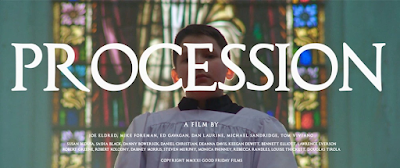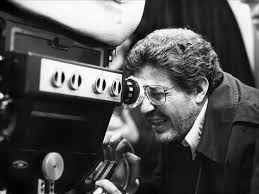 |
| Ryûsuke Hamaguchi |
For those who are unfamiliar with Ryûsuke Hamaguchi’s works, Wheel of Fortune and Fantasy is very much of the realm of Haruki Murakami’s short stories; three vignettes that ruminate on the themes of love, betrayal, chance encounters and coincidences.  |
| Fantasy or fortune? |
I was lucky enough to catch one of Hamaguchi’s film, Asako I & II which was screening on Stan about 2 years ago. It had a dreamy quality: elliptical and haunting, the story stayed with me for a number of days and although I can’t recall the storyline in detail, that feeling still remains when I think of this film.
Wheel of Fortune and Fantasy aims to create those kinds of connections and feelings, and succeeds especially well in the last of the three vignettes. And unlike Rohmer, (the director cites him as his main influence), his stories seem to have a less sunny disposition.
The three stories have their own distinctive narratives, casts and impulse; and each are a self -contained exploration of the human psyche. The first piece is called Magic (Or Something Less Reassuring) and unfortunately I found that for the first 15 minutes or so the screen was too dark, and I saw virtually nothing...either the key light was not set correctly (which I doubt) or the cinema (Dendy Newtown) had not calibrated it’s screens properly. The simple two-shot sequence in the cab was obscured and made it hard to establish a character’s motive or intent without the ability to see their faces, to read their eyes. The saving grace was at the end of this segment - where fantasy ends.
 |
| Chance and coincidence |
The three stories are mainly two-handers and work extremely well as chamber pieces heightening the melodrama that unfolds, sometimes in real life, and sometimes within our mind’s eye. The only clue that provides a connective thread across the pieces is Robert Schumann’s Of Foreign Lands and Peoples played extra-diegetically on the piano (as though someone is practising), and this earworm so far has not left me. A beautiful rendition of this piece played by the great Martha Argerich when she performed with the Berliner Philharmoniker at 73 years of age can be found here; and boy, can she play! She still has the most graceful and lightness of touch).
This piece of music perfectly describes each of their encounters. Human endeavour and behaviour are generally strange and foreign. Even when we’re in the act of thinking or doing something, we never consider its strangeness except in hindsight. And whilst it all makes sense at the time, like those stolen moments between love-making in the second story Door Wide Open, where anything promised is possible and any attempt at realising these promises should, of its own accord, take on its own impulse and may even develop into something special. But in hindsight, we all know that these actions, tempting as they may be, will ultimately lead to an unfortunate demise for those involved. It is written. The story notwithstanding, in this segment Kiyohiko Shubukawa was fantastic as the deadpan professor and novelist.
 |
Second Segment- Door Wide Open
with Kiyohiko Shubukawa in the foreground |
And for those who come together unexpectedly, such as the two women in the last segment, Once Again, they may find an altogether a different ending to the one they set out to achieve. It is through these small moments of observation and dialogue that Hamaguchi re-invents the episode genre, and you come away with the feeling of having experienced, visually, a Murakami collection of short stories.
To get to a deeper understanding of this film (without further spoilers) there is a really good interview with the director from this year’s New York Film Festival here.
 |
| Ildikó Enyedi |
Ever since I saw Ildikó Enyedi’s On Body and Soul and heard her speak about her film at the SFF back in 2017 (it took out the SFF Award for Best Film that year), I have been full of admiration for her and her very unique way of relating the magical realism of nature, in particular, animals, to her narratives and, of course, to us, the very extraordinary thing of being human.
I found The Story of My Wife to have that same enchanted quality, but with a maturation of perspective and treatment of a similar subject matter. Sure, we can say that this film is a story about love, or about a man (a Sea Captain) and his wife (the first woman who walked through the door on that fateful day). But can women and men ever really understand each other? Because falling in love, or loving another person is altogether a different matter.
 |
| Léa Seydoux, Gijs Naber, Louis Garrel |
The greatest folly of mankind is our ability to be influenced by love’s tidal tempers, and our greatest extenuative is our inability to understand this profound sentiment and our ineptitude in our search for its yearning.
Or perhaps what is to be found in the oscillation between these two states, (alas, these two worlds), of being in the state of love (the swoon that sweeps you off your feet), to the way we need to overcome it is by way of creating misdirections, seeding doubts, mythmaking; all in order to break the same bonds we so desire, lest our hearts may never recover from them.
Those critics who have given this film and it’s glorious 2 hours and 49 mins a thumbs down review, I dare say dont have not the patience or subtlety to truly want to grasp at the mysterious heart of the story. That Otherness is an essential and constitutional part of the formulation of Self. The Other is always mysterious and cannot be otherwise. All we can do, is to take delight in navigating in the unknown waters in between.
The story unfolds in a series of episodes, each with a chapter heading, the last one is “On Letting Go”. The film is adapted from a novel of the same name The Story of My Wife: The Reminiscences Of Captain Störr by early 20th Century Hungarian writer, Milán Füst.
Ildikó Enyedi’s film transports us to another time, with Imola Lang’s gorgeous production design - the 20s and 30s set pieces offer up a centre of balance. But the home is the loci of both love and illicit thoughts, a husband and wife’s private space is also the scene of confrontations.
 |
Léa Seydoux's Lizzy and Gils Naber's Captain Störr -
at a time when they were very much in love. |
For Léa Seydoux, her Lizzy was always true to her husband, Captain Jakob Störr, played by the handsome and Viking-like Dutch actor Gijs Naber, but she is totally mysterious to him. She was the Eve of dry land, and all Störr could do was to dream with the sperm whales ‘standing’ vertically in the water. These deep ocean sirens sleep standing up, and Störr is at one with their songs. He walks on land as a man, but has a heart of a whale. His dream literally comes true when he declared that he was going to marry the first woman who stepped through the door, and he did.
The homely setting, the hearth, the chaise and a reclining Lizzy reading, this scene welcomed the sailor back as though he was Ulysses, and her, Penelope. After all, this home was in Paris, and she has not yet been displaced to Hamburg.
Lizzy is ambivalent, and that perhaps is her charm after all, setting aflutter all the hearts of men (and women) who come across her path. But she is very much the faithful wife to Störr, whether he saw it or not, understood it or not, believed it or not. Her small jibes “what an absurd thing to say”, or “what a ridiculous notion”, were her only defence of the deeper wounds his suspicions and jealousy drove into her, (he did try to strangle her), and perhaps as an aggrieved woman, there was simply not a way to express this feeling except to be a creature of contradiction: contemptuous (pushing idly, inch by inch, the ink well until it falls off the edge of the table), charming (coming home tipsy and proud of the fact of having spent a good evening out), and sensual (dancing in front of mirror when no one was watching). That was the person whom Störr fell in love with.
 |
| "Before the inkwell hits the ground" |
But for Störr, unfaithfulness, just like trafficking illegal goods, is a common affair. Hints abound throughout the early parts of the film eluding to his shipmates’ having a ‘wife’ at every port. Though he confessed of having ‘no wife’, but later, having given up his seafaring days (partly to keep an eye on Lizzy), his own calculated ways made him think the worst of his wife. And Louis Garrel’s dandy, Dedin, affronted the worst in him. He has still to learn how to sing Lizzy’s siren song.
Later, when Störr mistook his own indiscretion for love, having been attracted to Grete (Luna Wedler (from the fantastic German Netflix series, Biohacker), he wanted to take their stolen relationship further. But Grete knew it to be useless, she was “like him” she said, with a truthful heart; and we know it was her innocence that spoke. She was already in a double bind whether she saw it or not. To be his mistress (it doesn’t matter that he asked her to marry him - as an audience, we knew he meant to have two wives), or to be without him.
There was to only be one eternal ending to this story. A sequence towards the end of the film was of Störr holding a posy of violets and standing at the back of a tram. As it pulled away from the cafe he was at earlier (where he had eyed a girl who had caught his fancy), he sees her, Lizzy. The posy falls from his hands. The beautiful blue violet that symbolises modesty and faithfulness, and also of remembrance; and in Shakespeare - of sorrow and death. This single gesture tied to this flower tells the entire story of Captain Störr and his wife.































